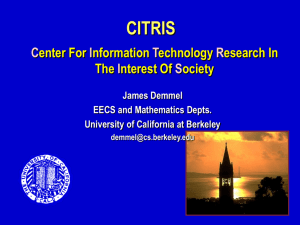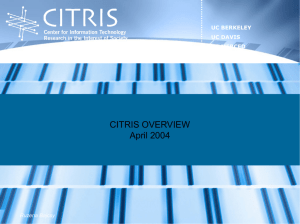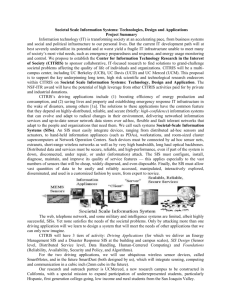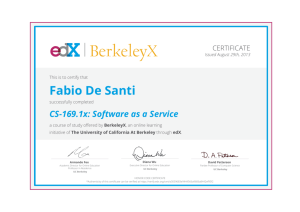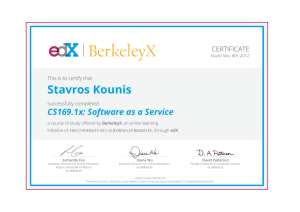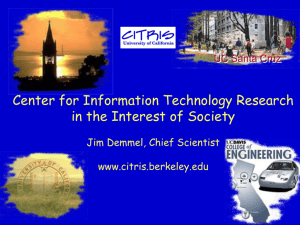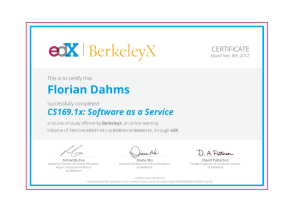in Word - Computer Science Division
advertisement
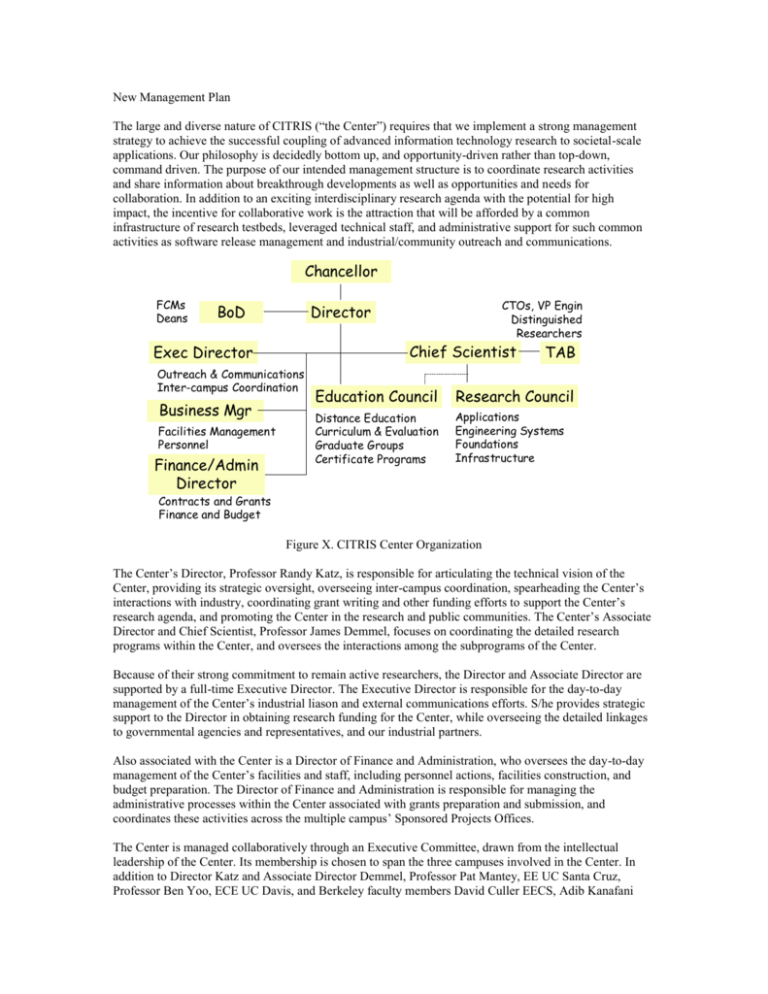
New Management Plan The large and diverse nature of CITRIS (“the Center”) requires that we implement a strong management strategy to achieve the successful coupling of advanced information technology research to societal-scale applications. Our philosophy is decidedly bottom up, and opportunity-driven rather than top-down, command driven. The purpose of our intended management structure is to coordinate research activities and share information about breakthrough developments as well as opportunities and needs for collaboration. In addition to an exciting interdisciplinary research agenda with the potential for high impact, the incentive for collaborative work is the attraction that will be afforded by a common infrastructure of research testbeds, leveraged technical staff, and administrative support for such common activities as software release management and industrial/community outreach and communications. Chancellor FCMs Deans BoD Chief Scientist Exec Director Outreach & Communications Inter-campus Coordination Business Mgr Facilities Management Personnel Finance/Admin Director CTOs, VP Engin Distinguished Researchers Director TAB Education Council Research Council Distance Education Curriculum & Evaluation Graduate Groups Certificate Programs Applications Engineering Systems Foundations Infrastructure Contracts and Grants Finance and Budget Figure X. CITRIS Center Organization The Center’s Director, Professor Randy Katz, is responsible for articulating the technical vision of the Center, providing its strategic oversight, overseeing inter-campus coordination, spearheading the Center’s interactions with industry, coordinating grant writing and other funding efforts to support the Center’s research agenda, and promoting the Center in the research and public communities. The Center’s Associate Director and Chief Scientist, Professor James Demmel, focuses on coordinating the detailed research programs within the Center, and oversees the interactions among the subprograms of the Center. Because of their strong commitment to remain active researchers, the Director and Associate Director are supported by a full-time Executive Director. The Executive Director is responsible for the day-to-day management of the Center’s industrial liason and external communications efforts. S/he provides strategic support to the Director in obtaining research funding for the Center, while overseeing the detailed linkages to governmental agencies and representatives, and our industrial partners. Also associated with the Center is a Director of Finance and Administration, who oversees the day-to-day management of the Center’s facilities and staff, including personnel actions, facilities construction, and budget preparation. The Director of Finance and Administration is responsible for managing the administrative processes within the Center associated with grants preparation and submission, and coordinates these activities across the multiple campus’ Sponsored Projects Offices. The Center is managed collaboratively through an Executive Committee, drawn from the intellectual leadership of the Center. Its membership is chosen to span the three campuses involved in the Center. In addition to Director Katz and Associate Director Demmel, Professor Pat Mantey, EE UC Santa Cruz, Professor Ben Yoo, ECE UC Davis, and Berkeley faculty members David Culler EECS, Adib Kanafani CE, David Patterson EECS, Al Pisano ME, and Paul Wright ME. In addition, Dean Richard Newton and Berkeley EECS Department Chair Shankar Sastry serve as Ex Officio members of the CITRIS Executive Committee. The Executive Committee meets on a frequent basis to assist the Director in making resource allocation, policy, and other management decisions relevant to the operation of the Center. Major polices are also reviewed for issues and constructive feedback with the Center’s at-large investigator community. The Executive Committee is also responsible for proactively reviewing the progress of the Center towards its research and educational goals, and influencing the direction taken by the Director in his/her management of the Center. Nevertheless, the Director retains ultimate decision making authority and responsibility for the success of the Center. The ITR (“the Project”), if funded, will be one of several large projects that constitutes the portfolio of sponsored research within the Center. The Project will be led by Principal Investigators Professor James Demmel and Professor Shankar Sastry. They will have direct reporting responsibility to the National Science Foundation for the success of the Project. They will coordinate with the CITRIS Director for access to the Center’s resources, such as access to research testbeds and other technical and administrative resources. As Demmel is also the Chief Scientist and Associate Director of CITRIS, and Katz is a coPrincipal Investigator of the Project, we expect this coordination to be highly collegial and effortless. The Center makes use of two external boards for advice, direction, and feedback: the Board of Directors (BoD) and the Technical Advisory Board (TAB). The Director reports to the BoD, which is drawn from the Deans of Engineering at Berkeley, Davis, and Santa Cruz, and senior representatives (e.g., Vice President of Engineering or Chief Technology Officer) from the founding members of CITRIS. The latter consists of BroadVision, Ericsson, Hewlett-Packard, IBM, Infineon Technologies, Intel, Marvell, Microsoft, Nortel Networks, ST Semiconductors, and Sun Microsystems. The Chairman of the BoD is the Chancellor of the Berkeley campus, Dr. Robert Berdahl. It is the responsibility of the CITRIS Director to meet quarterly with the Board to review the status of the Center, assess its progress towards its technical goals, evaluate the success of its technology transfer and outreach activities, and suggest new directions for research. The Board provides advice and directions, and is empowered to recommend the replacement of the Director if necessary. The TAB is constituted from distinguished senior members of the international research community drawn from industry, academia, and government, and broadly representative of the research expertise of the Center. It is the responsibility of the Center’s Chief Scientist to review the research agenda of the Center with the TAB, to seeks its advice and suggestions for prioritizing the research activities of the Center to maximize its relevance and impact. To insure that adequate attention is paid to the broader social agenda of the Center, the TAB membership will include social scientist scholars as well as experts drawn from engineering disciplines. In particular, Professor Pat Samuelson of Boalt School of Law, an expert on intellectual property rights in the digital age, Sociology Professor Manuel Castells, an expert on the impact of network technologies on societal organization, and Regional Planning Professor Annalee Saxenian, an expert on regional development’s impact on the clustering of high technology industries, all of the Berkeley campus, have agreed to serve on the Center’s TAB. Within the Center, it is essential that we provide effective coordination across research efforts in the diverse technical areas of applications, systems, foundations, and shared research infrastructure. Furthermore, the Center must provide a unified management mechanisms for our interactions with a potentially large collection of geographically dispersed industrial, academic, and Government of California collaborators. This will be accomplished through a Research Coordination Council (“the RCC”) with rotating membership drawn from the CITRIS investigators. The RCC has one representative each from the applications, system technologies, foundations, and research infrastructure activities within the Center, as well as the Center Director and its Chief Scientist. The initial membership of the RCC is Katz as Director, Demmel as Chief Scientist, Professor Adib Kanafani (Civil Engineering, Berkeley) representing Applications, Professor David Culler (Electrical Engineering and Computer Science, Berkeley) representing systems technology, Professor David Patterson (Electrical Engineering and Computer Science, Berkeley) representing foundations, and Professor Ben Yoo (Electrical and Computer Engineering, Davis) representing infrastructure. It is through their involvement in the RCC that they also serve on the Center’s Executive Committee. The investigators have an enviable record of successful technology transfer across a broad set of technical fields, including computer-aided design software (starting with SPICE in the 1960s), computer architecture (including RISC and RAID), parallel systems (NOW), and numerical software (SCALAPACK). We have refined an effective strategy for managing our interactions with industry and government sponsors over the last several years is based on periodic research retreats. These off-site meetings take place twice a year, typically in January and June. The program mixes research highlight presentations with graduate student poster sessions, work-in-progress presentations, and workshop-oriented brainstorming breakout sessions. An essential part of the retreat model is the participation by industry and government representatives, who during the three day period of the retreat intensely interact with the graduate students, present their own research needs and ideas to the assembled group, and provide detailed feedback and criticism to the graduate students and the faculty investigators. This level of engagement has been very important for carrying the developments of the research project back to industry. Furthermore, the Center will provide facilities for Visiting Industrial Fellows, to enable them to spend time on campus, working more closely with the research groups. The Center is committed to making its results widely available for educational and research usage. Our general philosophy is to provide no-fee, nonexclusive licenses for the Center’s research products, particularly software, to its industrial sponsors--even for commercial development. This approach is consistent with a new experimental policy recently put in place by the University of California. Among the professional technical staff of the Center are experts able to assist in the creation of high quality software releases, and provide technical documentation and support. The primary mode of delivery of information about the Project will be through Web pages, created by the Center’s staff, but also brochures and other physical documents as required to present the results of the Project to a variety of target communities.
